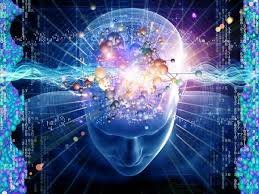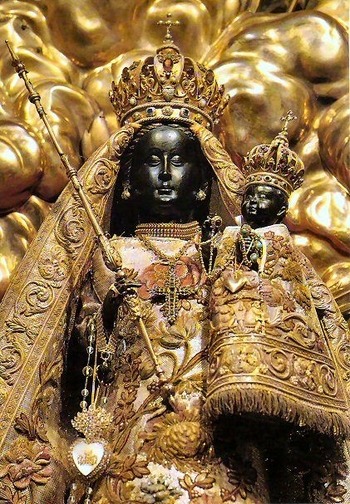
They are of Romanesque style, sculpted in the 12th and 13th centuries. As far as we know no French Black Madonnas were sculpted until the 1100's and none were mentioned in literature until the 1500's. This was when alchemy and its symbols (including labyrinths) came out into the open. In alchemy black stands for the death of the false self and birth into new life.
They are portrayed in the position called "majesty" or "Seat of Wisdom". That is to say, Mary sits on a throne with a low back; she holds a toddler Jesus on her knees; both look straight ahead - no demurely down cast eyes. In the language of medieval symbolism this means that Mary is the throne of Jesus, the Seat of Wisdom. From her lap spring wisdom and power.
Seat of Wisdom was also one of the titles of the Egyptian goddess Isis, like Mary, often portrayed with her son Horus on her lap.
They often measure 70 centimeters in height, 30 cm in width, and 30 cm in depth. This 7:3 proportion echoes sacred numerology that goes back to pre-Christian times. In the Christian context it speaks of the union of God (the 3 persons of the trinity) and his creation (made in 7 days).
They were enshrined at places that were sacred even before Christianity, pagan holy sites and natural "power spots" of exchange between heaven and earth.
They all are said to have some connection to the Holy Land or its neighbors, like Egypt or Syria.
Their shrines all have a connection with either the Benedictines, the Cistercians, or the Knights Templars. American scholars acknowledge at least 450 Black Madonnas world wide, still counting.
Some of the most important Pre-Christian goddesses who were worshipped side by side with Christ, overtly until the 6th century, covertly until the 11th, were associated with the color black. Why? Going back to prehistoric times, black was the symbol for the earth and the Great Mother, the source of heaven and earth. The darker earth is, the more fertile, hence black is the color of fertility and creative power. But the ancient peoples knew that that which has power to create and to bring forth life also has power to destroy.
It does not seem a coincidence at all that it was here that the Christian Council of Ephesus in A.D. 431 proclaimed Mary “Mother of Godâ€, formerly a title of the Great Goddesses. Perhaps divine providence brought the Virgin Mary and one of the most revered goddesses of her time together in one place for a purpose. Brigitte Romankiewicz reports that at the time of the council many shrines to Isis and Kybele had been abandoned by decree of the Roman empire. Now the council decided to christen 48 of them into shrines to the Virgin Mary.
For much more of the article..... http://interfaithmary.net/pages/webblackmadonna.html
 It turns out I am "Earth".
It turns out I am "Earth". 






















